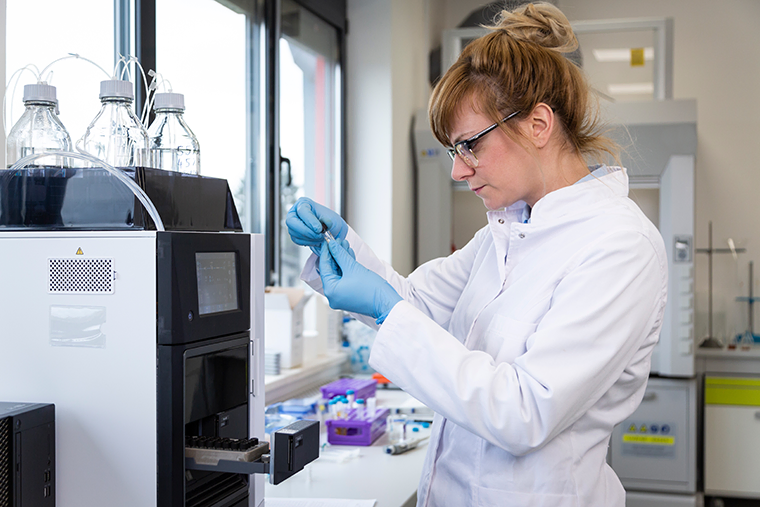Chromatography is an analytical technique that involves separating the constituents of a mixture into individual components. Once separated, the components can be analysed or used for purification purposes.
There are various types of chromatography, but one of the simplest is paper chromatography, which allows you to separate colours in a mixture. You can use this technique to separate washable black ink into its component primary colours, for instance.
The differences in the paper adhesion and solubility of the individual colour components cause them to separate out on the chromatography paper, creating a rainbow-like effect. Similar principles can be applied to separate and identify the molecular components of certain mixtures, such as the DNA in chromosomes.
Read on to learn more about how chromatography works, what it’s used for, the different methods, and how to calculate the retention factor (Rf) value.
In this post:
What is chromatography & what is it used for?
Chromatography is the separation of the constituent components of a mixture during a mobile phase and a stationary phase (more on these below).

To perform this technique, the mixture that’s being analysed is first dissolved in a fluid solvent. This fluid, which can be a gas or a liquid, is called the ‘mobile phase’. It carries the mixture’s components through a system on which the material is fixed. This is known as the ‘stationary phase’. The system itself can be made of various solid objects such as a stainless steel column, a glass capillary tube, a sheet of paper, or a metal plate.
Subtle differences in the affinities of the constituents of a mixture during the mobile and stationary phases allow them to be separated. Essentially, the constituents travel at different rates, which results in the differential partitioning and retention of the constituent components.
Being able to separate the constituents of a mixture is a very useful analytical method. Unsurprisingly, chromatography therefore has a wide range of applications including drug testing, forensics, food testing, and genetic studies.

Where did chromatography originate from?
The use of chromatography as a scientific tool can be traced back to the botanist Mikhail Tswett in 1903. He developed a technique for separating plant pigments like chlorophyll and xanthophylls.

What are the 4 types of chromatography?
The four main types of chromatography are: adsorption chromatography, thin-layer chromatography, column chromatography, and partition chromatography.
There are also various other methods, including special techniques like hydrophobic interaction chromatography, chiral chromatography, two-dimensional chromatography, and pyrolysis gas chromatography. Despite there being many different techniques, all of them follow the same basic principles.
Although the materials and the intended analytes may vary, chromatography methods can be classified into a few generic categories. For example, they can be grouped according to the type of stationary phase used. Some of the main types of chromatography techniques are summarised below.
As the name implies, this type of chromatography involves an adsorbent medium. Adsorption chromatography techniques separate chemical mixtures based on the adsorbent properties of a stationary phase. One common example of this is paper chromatography, whereby the constituents of a mixture are separated as they differ in their affinity on the surface of a paper filter.
Thin-layer chromatography uses a thin stationary phase (typically silica gel or alumina) that’s supported by an inert backing. A popular and relatively simple technique, TLC can be used for analytical or purification purposes. Like other chromatographic methods, the constituent components have different affinities for the mobile and stationary phases, which causes the mixture to separate.
Column chromatography is mainly used as a precursory method for separating compounds based on their polarity and hydrophobicity. For example, petroleum oil mixtures can be separated based on the different densities of their constituents. The stationary phase is usually contained in a laboratory burette.
This technique relies on the polarity of the solutes. In this type of chromatography, the stationary phase is polar, while the mobile phase is either non-polar or has low polarity. The process can also be reversed by using a non-polar stationary phase and polar mobile phase (known as reverse-phase partition).
What is the Rf value?
The Rf value, or retention factor value, of a material is calculated as a ratio between the distance travelled by a solute from a baseline and the distance travelled by a solvent from a baseline.
The differences in the affinities of a solute and a solvent on a surface make it possible to separate the constituents of a mixture when it moves on a surface, either with the aid of gravity or by using electricity. The respective molecular mass, polarity and affinities of the solute and solvent on the surfaces are the main factors that determine the Rf value.
Certain environmental factors can also determine or affect the Rf value. These include the temperature, chromatography medium, solvent concentration and purity, and the amount of sample.
The Rf value is a more objective way of measuring and comparing known components and unknown components of a mixture. Given a controlled sample of chromatography for a particular substance, the Rf value can be used as a baseline value for analysis.
What is the stationary phase in chromatography?
The stationary phase in chromatography refers to the medium, which can either be solid or liquid, that’s fixed on a glass or metal surface. It’s where the mobile phase passes and where the components of a mixture are separated. The modes of action vary and require meticulous selection based on whether the technique is being performed for analytical or purification purposes.
Porous solids such as glass, silica, or alumina, are used as the stationary phase. The stationary phase is generally packed inside a glass or metal tube. The mobile phase that contains the analyte mixture flows through the stationary phase.
What is the mobile phase in chromatography?
The mobile phase in chromatography refers to the liquid or gas substance that carries the analyte through the stationary phase. An analyte’s constituent components separate because they have different affinities with the stationary phase. Each constituent travels at different speeds along the stationary phase. Consequently, components are sequentially left behind and retained as smudges on the stationary phase at different locations.
What factors affect chromatography?
There are a variety of internal and external factors that can affect the chromatography process.
Internal factors tend to relate to the different phases and properties of the analyte, including its molecular mass and polarity. External factors, however, include physical factors surrounding the chromatography analyte such as temperature and the type of medium that’s being used for the stationary and mobile phases.
Summary
Chromatography is a popular technique that can be used in both analysis and purification. Although there are different types of chromatography methods, they all separate the components of a mixture through a mobile phase and a stationary phase. Several factors can affect the chromatography process, but the results can be objectively measured and compared using Rf value.
You can learn more about chromatography and organic chemistry in our student resources hub.












